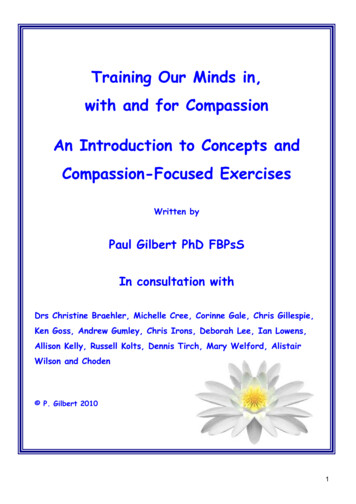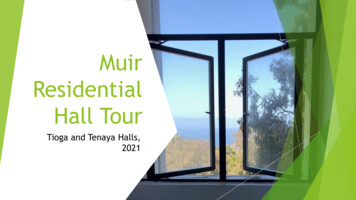
Transcription
The History of Gumley House, Isleworth, LondonThe name Gumley is not a common one. It is thought to have originated in France, where ithad a slightly different spelling, (Gommeley, or perhaps Gautchmondley) but the samepronunciation. Whatever its origins, it has, since 1700, been associated with GUMLEYHOUSE in Isleworth, Middlesex. Although unremarkable architecturally, the house on theTwickenham Road has an interesting history, more than half of which is bound up with theschool founded by Madame d'Houet, the foundress of the Faithful Companions of Jesus.1700The original house was built by John Gumley, cabinet maker by appointment to George Iand George II. He specialised in mirrors, one of which still hangs in Hampton Court Palaceand two in Chatsworth House, Derbyshire. John Gumley had a shop in the Strand, London,but he lived in Isleworth, taking an active part in local life there, and was a church wardenfor many years.1714John’s eldest daughter Anna Maria, married William Pulteney who later became Earl ofBath and played an important part in political affairs during the reigns of three monarchs:Queen Anne, George I and George II1723Gumley was the treasurer of the Isleworth Charity School and treasurer of the workhouse (1728).He and his wife Susan had three sons and four daughters. The eldest son George is described as'very profligate and disobedient and not to be trusted with an ample fortune.' He was cut offwith 150 a year.
1722Through the influence of his son-in-law, John Gumley entered Parliament as member forSteyning in Sussex1724He was given the post of Commissary General to the Army, a position that increased hisfortune. A lot of money could be made through army contracts.Anna Maria was admired for her beauty, but not for her good character. Alexander Popedescribes her as: 'Fantastic, vain and insolently fair. Grandeur intoxicates her giddy brain.'(The Looking Glass) He advises her to look into one of her father's mirrors and 'by reflectionlearn to mend her face.'1721The architect, James Gibbs was employed to make alterations and improvements to thehouse. He added the Colonnades in the front and made improvements in the attics.
1728John Gumley died in December and was buried on Boxing Day at All Saints Church. In hiswill he left Gumley House to his second son, John. His widow continued to live at Gumleywith her youngest daughter, Laetitia.1735When Laetitia married Lancelot Charles Lake, Anna Maria and William Pulteney came tolive at Gumley. While the Pulteneys were in residence Gumley was visited by manyimportant people, among them Alexander Pope, Dr. Johnson, Addison and the future PrimeMinister William Pitt1750Susan Gumley died. Gumley House passed on to Laetitia Lake and her husband, then to theirson General Lord Lake, who does not seem to have spent much time at Gumley. He wasaway fighting in the American War of Independence and the house was probably let until itwas sold to Benjamin Angell in 17951795The house sold to Benjamin Angell who came from Chippenham in Wiltshire. He was achintz printer and dyer. He and his wife Sarah were Quakers and led a very simple life.1817Benjamin Angell died. His widow, Sarah, continued to live at Gumley until her death in1835
1835After Sarah's death, the house then came into the possession of Sarah's neice, Elizabeth andher husband, Charles Allen1839While on a business trip to France, Charles Allen became ill and died at the early age of 47.His widow found that there was not enough money for her to keep the estate going. It wasput on the market and sold to Madame d’Houët in 18411840 – 41Madame d’Houët, foundress of the Faithful Companions of Jesus, bought Gumley House andestablished it as Catholic educational establishment. This was the beginning of a new era inits history: for the first time it was not to be lived in as a family home. Two schools werethen founded on the Gumley House property: a boarding school for the wealthy and a dayschool for the poor children of the parish. Extensive additions were made during the nexttwenty years. It was at this time too that the lake was filled in, being considered potentiallydangerous for the pupils. The boarding school was particularly useful to Catholic parentswho wanted to have their daughters educated in England, instead of sending them to Franceor Belgium, as had been the custom before the Catholic Emancipation Act of 1829Two of the most famous pupils of Gumley House in its early years, were the two princesses,Blanche and Marguerite. They were the daughters of Duc de Nemours, the eldest survivingson of the exiled King of France, Louis Philippe. The two young princesses were day pupils,living in Bushy Park and driving over to school each morning.The boarding school for 'young ladies' and the 'poor school' for the local children continuedto flourish. As the years passed, the need for a day school to provide secondary educationfor the children in the neighbourhood became obvious. In 1890 St Mary's High School wasopened.1907 a new building was erected and linked to St Mary's High School by a bridge.In 1920 a claim for the recognition of St Mary's High School as an approved secondaryschool was presented to the board of education. The school was duly recognised, with theproviso that steps be taken to build a properly equipped secondary school. The construction
of the new building began in 1921, and Cardinal Bourne opened the school on 21stSeptember 1922. It became known as St Mary's College and was the first Catholic School inMiddlesex to be recognised by the Board of Education1920a claim for the recognition of St Mary's High School as an approved secondaryschool was presented to the board of education. The school was duly recognised, with theproviso that steps be taken to build a properly equipped secondary school. The constructionof the new building began in 1921, and Cardinal Bourne opened the school on 21stSeptember 1922. It became known as St Mary's College and was the first Catholic School inMiddlesex to be recognised by the Board of Education.In 1923 when the FCJ boarding school was opened at Poles in Hertfordshire, some of theboarders moved there from Gumley. However, during pre-war days there were alwaysboarders at Gumley. The boarding and day schools amalgamated as far as lessons wereconcerned, but the girls continued to wear different uniforms. The original St Mary's wastaken over by the primary school at this time.When the war started in 1939, the boarding school was temporarily closed. After the war,the boarders returned to Gumley but not in the same numbers and from 1968 Gumley nolonger accepted boarders.By 1959, Gumley house had developed into a two-form entry Grammar School. In 1960the Primary School moved across the road to new premises. In 1969 the octagonal hall wasbuilt. In 1971 a sports hall was built and A block was added. In 1974/75 the music suite,changing rooms and Howard block were added. In 1976 the first six-form entrycomprehensive intake was admitted to Gumley. Comprehensive schools were now a realityin many parts of the country.Thousands of pupils have passed through Gumley House Convent School since it opened in1841. Times have changed and certainly convents have changed. Gumley House had a new
building opened in April 1999. It was named the d’Houët Block after the Foundress of theFCJ Society.The school continues to thrive in 2010, with nearly 2000 girls on roll, between the ages of11 and 18 years. The FCJ community continue to live in the original building, in the groundsof the school.Text adapted from 'Gumley House Convent FCJ - A Short History'by Teresa White fcJ and Patricia Mabey
As the years passed, the need for a day school to provide secondary education for the children in the neighbourhood became obvious. In 1890 St Mary's High School was opened. 1907 a new building was erected and linked to St Mary's High School by a bridge. In 1920 a claim for the recognition of St Mary's High School as an approved seco ndary










